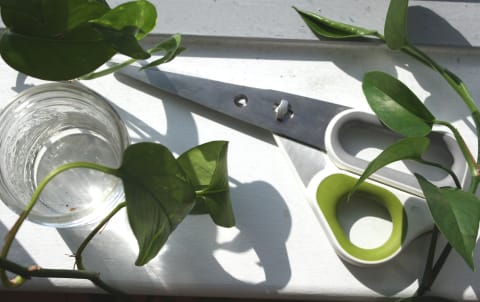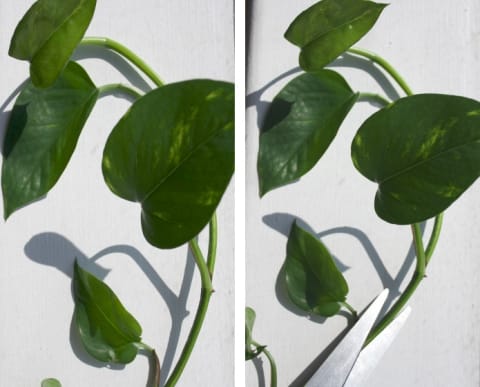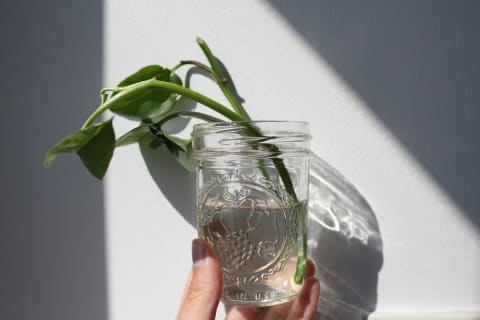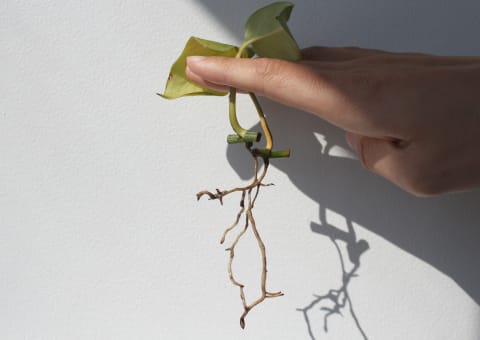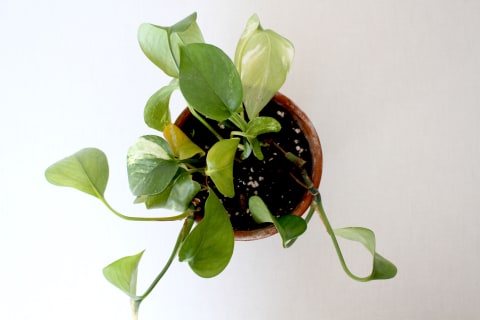Some plants lend themselves better to the technique than others, with quick-growing pothos (Epipremnum aureum) plants being some of the easiest to propagate. Here’s what you need to know to help your pothos plants multiply. “Once you’re comfortable with propagation, it’s a long-term planning way of looking at plants,” he explains, one that can also save you some serious cash at the greenhouse or plant shop. Depending on where your giftee is in their planting journey, you can either give them the cuttings alone, cuttings rooted in water, or a complete potted plant. Then, grab your healthy pothos. The better condition your starter plant is in, the better likelihood of successful propagation. “If you take a vigorous, healthy plant that has been growing in excellent light, it’s in a sense bursting with life—so even if you chop it up, those little pieces have enough energy to put out new growth,” he explains. Ideally, your cutting will also contain one or two leaves—though “sometimes you can even propagate if there are no leaves at all,” says Cheng. “If it’s just the stem with the nodes, that by itself can grow new plants.” The more cuttings you take from your initial plant, the fuller your new propagated plant will be. Once they grow roots, you can put all those cuttings into the same pot for a fuller look. Start by taking three to four cuttings, if your starter plant allows. Over time, the water gives the nodes an easy environment to begin forming roots. While you can technically skip the water step and just place your cuttings directly in soil, it leaves more room for error: You’ll need to water the soil extra carefully, making sure it’s just moist enough to give those roots a fighting chance at rooting. Putting them in water is more hands-off. “[Pothos is] a plant that can tolerate lower light levels but it will always thrive in bright, indirect light,” Betsy of the Betsy Begonia YouTube channel says. Then, you’re off to the races: Let your plant do its thing, replacing its water every two to three days or whenever you notice it getting murky. The water will create ideal conditions for your roots to start forming. Over time (about one to three weeks, depending on your plant and light conditions), you should notice little white strands start to stick out of your nodes: Those are the new roots. When the roots are about half an inch long, you can remove your cuttings and get them ready to transfer to soil. No need to break out the measuring tape to see if you’re at that half-inch mark: Since you can theoretically place cuttings directly in soil, the length of the root isn’t super important. Likewise, you can leave your cuttings in water for a while, until their roots are much longer, and they should still thrive once you put them in soil. As long as you see new roots, regardless of length, it’s a sign that your cuttings should grow well. Your plant’s leaves might look a bit patchy at first, but over time they should fill out in the right conditions. She says that drooping leaves can be a sign your pothos needs water. A bunch of yellowing leaves usually signal you’ve overwatered. “I fertilize mine every two to three months during the growing season, which is March to November in the Northern Hemisphere,” she adds. “Basically when you start seeing new growth in spring you can fertilize with a balanced houseplant fertilizer.” This means that if you have a few different types of pothos plants at home, you can take a cutting or two from each and put them in the same pot to grow a fun composite plant. This stem-cutting propagation technique also works for monstera and philodendron plants. Emma received her B.A. in Environmental Science & Policy with a specialty in environmental communications from Duke University. In addition to penning over 1,000 mbg articles on topics from the water crisis in California to the rise of urban beekeeping, her work has appeared on Grist, Bloomberg News, Bustle, and Forbes. She’s spoken about the intersection of self-care and sustainability on podcasts and live events alongside environmental thought leaders like Marci Zaroff, Gay Browne, and Summer Rayne Oakes.


